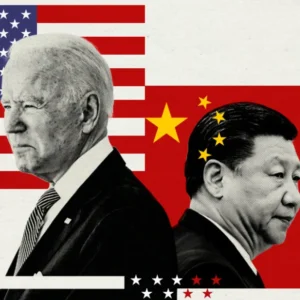The Un ited States has been taking various measures, that began in October to limit China’s access to breakthrough technology. The US has launched yet another major effort in a similar direction, with a particular focus on China, to limit foreign entities’ influence over its cutting-edge semiconductor technology in the ever-evolving field of technology. These trends have far-reaching consequences not only at home, but also throughout global supply networks, the worldwide tech sector, and the intricate web of geopolitical linkages.
ited States has been taking various measures, that began in October to limit China’s access to breakthrough technology. The US has launched yet another major effort in a similar direction, with a particular focus on China, to limit foreign entities’ influence over its cutting-edge semiconductor technology in the ever-evolving field of technology. These trends have far-reaching consequences not only at home, but also throughout global supply networks, the worldwide tech sector, and the intricate web of geopolitical linkages.
The U.S. Commerce Department’s Strategic Update
According to recent findings, the US Department of Commerce has launched a strategic change aimed at limiting China’s access to modern computer chips and the critical gear required for their fabrication. According to The Hindu, this decision underlines growing concerns about the vulnerabilities to national security posed by the spread of cutting-edge semiconductor technology beyond the borders of the United States.
The Importance of the United States Department of Commerce’s Announcement The United States Department of Commerce’s historic declaration marks a major shift in the country’s approach to safeguarding crucial semiconductor technology. The program is critical because it is designed to thwart China’s efforts to obtain cutting-edge computer components and the necessary technology for their manufacturing. The motivation for this strategic update is inextricably linked to growing concerns about national security vulnerabilities caused by the international spread of cutting-edge semiconductor equipment and expertise.
The Tightening of Export Controls

The tightening of export controls is a critical feature of this new development. Licenses will now be required for the shipping of cutting-edge computer chips to Chinese chip design firms. As Bloomberg points out, this restriction not only prevents China from directly acquiring these critical components but also adds an extra degree of scrutiny to oversee and manage leaving exports.
Rationale Behind the Measures
The rationale for these severe safeguards is based on the special capabilities inherent in these cutting-edge computer processors. They are critical in a wide range of technological sectors, including machine learning, artificial intelligence, telecommunications, and defense applications. Modern semiconductors have developed as a vital cog in modern life, emphasizing the importance of their protection.
Geopolitical Implications
On the world stage, discussion of this latest geopolitical play abounds. It has far-reaching implications, notably in the realm of geopolitics. The United States’ decision to restrict China’s access to advanced microprocessors is significant because it has the potential to spark innovative developments in a variety of industries. The global technological environment is closely intertwined, with actions made in one country having far-reaching consequences. As a result, this action serves as a catalyst for in-depth discussions on power dynamics in the tech industry and their relevance to global politics.
Economic Consequences

These activities have significant economic ramifications in addition to geopolitical implications. Any restrictions imposed on China’s access to cutting-edge computer chips, as a country at the forefront of technological innovation, may have a significant impact on both the country’s tech sector and the larger economy. According to The Times, China has made great progress in building its semiconductor industry, and the United States’ deliberate measures may stymie these advancements.
Broader Implications for the Technology Sector
These measures ripple through the IT industry, extending beyond geopolitical and economic factors. The semiconductor sector sustains intricate connections within international supply chains. Constricting exports to China may disrupt these supply chains, to the detriment of businesses and industries reliant on Chinese technology and manufacturing.
In essence, these activities have the capacity to influence the course of technological advancement. According to China Briefing, advanced computing processors are the foundation of many innovative innovations. Accessibility constraints may stymie progress in emerging fields such as artificial intelligence, driverless cars, and advanced robotics. The fundamental motivation for these preemptive actions is to protect national security. In an era where technology is critical to defense systems, intelligence-collecting tactics, and seamless communication networks, protecting cutting-edge semiconductor technology has become critical.
The Biden Administration’s Role
The rigorous preparation behind these projects owes much to the Biden administration’s legacy. These activities are a continuation of measures begun in October when deliberate actions were made to limit China’s access to breakthrough technology, as reported by Bloomberg. The basic goal is clear: to safeguard the nation’s scientific prowess and inviolable security interests while deftly navigating the convoluted maze of difficulties relating to the free transfer of technological expertise to foreign states.
Conclusion
The drive by the United States to restrict China’s access to modern computer chips is a multidimensional endeavor involving global geopolitics, economics, national security, and the future of technology. Despite its primary goal of protecting American interests, their acts have far-reaching consequences. Their possible ramifications send ripples across the fabric of global innovation, necessitating reflection on the fragile balance of power in the tech sector. As this fluid scenario develops, it is critical to closely monitor other governments’ reactions and the ramifications for the global technology industry.










Comments 1